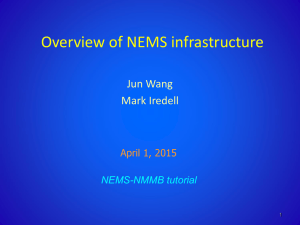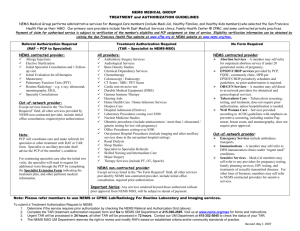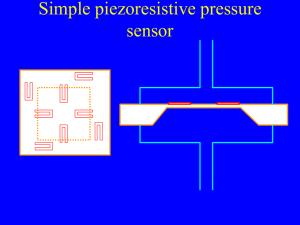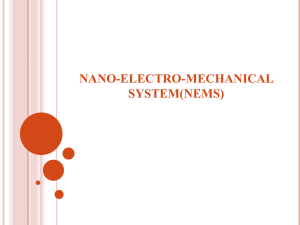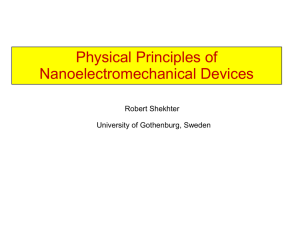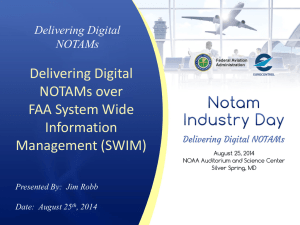NEMS
advertisement
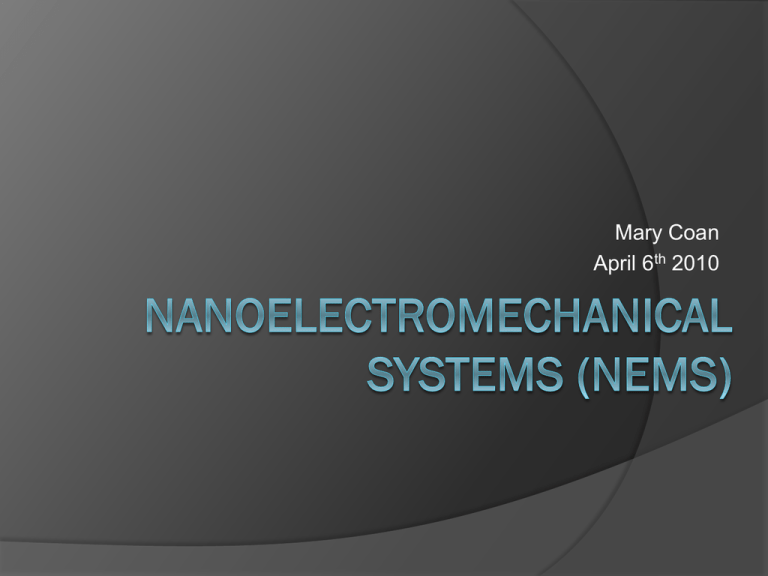
Mary Coan April 6th 2010 Outline How it all began… Nanoelectromechanical Systems (NEMS) Basic Properties Typical Problems Fabrication Processes Application of NEMS Conclusion How it all began… 1959-Richard Feynman offered a prize of $1000 "to the first guy who makes an operating electric motor - a rotating electric motor which can be controlled from the outside and, not counting the lead-in wires, in only 1/64 inch cube." stimulate new fabrication technology 1960-Bill McLellan, using amateur radio skills, built the motor with his hands using tweezers and a microscope 2000 rpm motor weighed 250 micrograms 13 parts Nanochamber ultrafast gas sensing with NEMS resonators http://www.nanowerk.com/spotlight/spotid=2431.php Image 1: http://nano.caltech.edu/gallery/group2.html Nanoelectromechanical Systems (NEMS) In the 50 years since The field of microelectromechanical systems (MEMS) caught up with Feynman's bet achieved commercial production capabilities of motors many times smaller NEMS devices integrating electrical and mechanical functionality on the nanoscale Research on building functional nanoscale Colorized SEM image Ultra underway electromechanical systems isofwell http://www.svtii.com/files/MEMS-NEMS-SVTI.pdf Image 1: http://nano.caltech.edu/gallery/group2.html High Fequency NEMS resonator Nanoelectromechanical Systems (NEMS) Used in aerospace, automotive, biotechnology, instrumentation, robotics, manufacturing and other applications SEM image of two Single Cell Pico Force SEMsensors - nanocantilever resonator Microscopy force Many functions gas sensor Sensing Actuation Communication http://www.svtii.com/files/MEMS-NEMS-SVTI.pdf Image 1&2: http://nano.caltech.edu/gallery/group2.html http://www.kschwabresearch.com/articles/detail/11 Nanomechanics coupled to superconducting microwave resonators Outline How it all began… Nanoelectromechanical Systems (NEMS) Basic Properties Typical Problems Fabrication Processes Application of NEMS Conclusion Basic Properties Two principal components common to most electromechanical systems Mechanical element ○ Either deflects or vibrates in response to an applied force ○ Used to sense static or time-varying forces Transducers ○ Convert mechanical energy into electrical or optical signals and vice versa ○ Input transducer simply keeps the mechanical element vibrating steadily while its characteristics are monitored as the system is perturbed http://www.nanowerk.com/spotlight/spotid=2431.php Image 1: http://palasantzas.fmns.rug.nl/NEMS.html Basic Properties Attain extremely high fundamental frequencies mechanical responsitvity Dissipate very little energy Characterized by the high quality or Q factor of resonance Extremely sensitive to external damping mechanisms Crucial for building many types of sensors Suppression of random mechanical fluctuations ○ Highly sensitive to applied forces http://www.nanowerk.com/spotlight/spotid=2431.php http://palasantzas.fmns.rug.nl/NEMS.html Image1: http://phycomp.technion.ac.il/~phr76ja/boston/what2.html Outline How it all began… Nanoelectromechanical Systems (NEMS) Basic Properties Typical Problems Fabrication Processes Application of NEMS Conclusion Typical Problems Great promise as highly sensitive detectors mass, displacement, charge, and energy An efficient, integrated, and customizable technique for actively driving and tuning NEMS resonators has remained elusive Electromechanical devices are scaled downward transduction becomes increasingly difficult ○ Causing the creation of finely controlled integrated systems to fail http://www.nanowerk.com/spotlight/spotid=2431.php Image1: http://phycomp.technion.ac.il/~phr76ja/boston/what2.html Typical Problems Resonator sizes continue to decrease to the nano-scale Surface to volume ratio increases ○ Susceptible to a variety of surface related noise mechanisms Such as gas molecules impinging the surface, loss due to defects and impurities, scattering of surface acoustic waves by roughness Surfaces contribute the most to energy dissipation in NEMS detailed understanding is still missing Nanoscale resonators exert relatively strong forces on tiny particles, leading the way to important advancements in MEMS and MOMS systems http://www.nanowerk.com/spotlight/spotid=2431.php http://www.gizmag.com/nanoscale-light-resonator/13401/picture/105479/ Image 1 Typical Problems Casimir Effect quantum mechanical force that attracts objects a few nanometers apart Very Strong Force ○ Hard to control devices Efficient actuation creation of mechanical motion by converting various forms of energy MEMS setup used to detect the rotating or linear presence of Casimir force. mechanical energy http://www.semiconductor.net/article/444199-Scientists_to_Conquer_Casimir_Effect_Enable_NEMS.php Typical Problems Fabrication Scale down effects ○ Lithography Wave length limitations Integration with typical CMOS processes Mass Production Packaging ○ Fragile Cost Top Image: http://www.texmems.org/ Bottom Image: http://www.nems.se/nimble.html Outline How it all began… Nanoelectromechanical Systems (NEMS) Basic Properties Typical Problems Fabrication Processes Application of NEMS Conclusion Fabrication Processes Basic Steps of Silicon Micromachining: Lithography Deposition of sacrificial and structural layers (PECVD, evaporation, sputtering) Removal of Material (patterning) Selective etching (RIE, Laser) Doping Bonding (Fusion, anodic) Planarization MEMS and NEMS: systems, devices, and structures Nano- and microscience, engineering, technology, and medicine series By: Sergey Edward Lyshevski Image: http://hello-engineers.blogspot.com/2009/04/mems-fabrication-assembling-and-packing.html Fabrication Processes UV Light Mask Photo Resist Mask Photo Resist Photo Resist Sacrificial Layer Sacrificial (SiO2)Layer Substrate (Silicon Wafer) Surface Micromachining and sacrificial layer technique http://iopscience.iop.org/0964-1726/10/6/301/pdf/sm1601.pdf?ejredirect=migration Animated Version Fabrication Processes UV Light Photo Resist (100) Silicon Wafer P+ Si SiNx Bulk Micromachining along crystallographic planes http://iopscience.iop.org/0964-1726/10/6/301/pdf/sm1601.pdf?ejredirect=migration Animated Version Fabrication Processes Left image: http://www.memx.com/ Right Image: http://www.npl.co.uk/science-+-technology/nanoscience/surface-+-nanoanalysis/mems-particle-detector Outline How it all began… Nanoelectromechanical Systems (NEMS) Basic Properties Typical Problems Fabrication Processes Application of NEMS Conclusion Application of NEMS: NEM switched Capacitor Demand for increased information storage Pushed silicon technology to its limits Research involving novel materials and device structures ○ Magnetoresistive random access memory ○ Carbon nanotube field-effect transistors NEM switched capacitor structure Vertically aligned multiwalled carbon nanotubes ○ mechanical movement of a nanotube relative to a carbon nanotube based capacitor defines ‘ON’ and ‘OFF’ states Impossible to control the number and spatial location of nanotubes over large areas JAE EUN JANG, et. al . “Nanoscale memory cell based on a nanoelectromechanical switched capacitor” Nature Vol 3 January 2008 doi:10.1038/nnano.2007.417 Application of NEMS: NEM switched Capacitor Carbon Nanotube Fabrication: Grown with controlled dimensions at pre-defined locations on a silicon substrate ○ Compatible with existing silicon technology ○ Vertical orientation allows for a significant decrease in cell area over conventional devices JAE EUN JANG, et. al . “Nanoscale memory cell based on a nanoelectromechanical switched capacitor” Nature Vol 3 January 2008 doi:10.1038/nnano.2007.417 Application of NEMS: NEM switched Capacitor JAE EUN JANG, et. al . “Nanoscale memory cell based on a nanoelectromechanical switched capacitor” Nature Vol 3 January 2008 doi:10.1038/nnano.2007.417 Application of NEMS: NEM switched Capacitor Data has been written to the structure Theoretically it is possible to read data with standard dynamic random access memory sensing circuitry Simulations have been completed high-k dielectrics instead of SiNx ○ increase the capacitance to the levels needed for dynamic random access memory applications JAE EUN JANG, et. al . “Nanoscale memory cell based on a nanoelectromechanical switched capacitor” Nature Vol 3 January 2008 doi:10.1038/nnano.2007.417 Application of NEMS: Self Sustaining NEM oscillator Sensors based on nanoelectromechanical systems vibrating at high and ultrahigh frequencies capable of levels of performance that surpass those of larger sensors NEM devices have achieved unprecedented sensitivity Displacement, mass, force and charge detection Passive devices Require external periodic or impulsive stimuli to excite them into resonance Novel autonomous and self-sustaining NEM oscillator Generates continuous ultrahigh-frequency signals when powered by a steady d.c. source X.L. Feng, et.al. “A Self Sustaining Ultrahigh-frequency nanoelectromechanical oscillator” Nature Vol 3 June 2008 doi:10.1038/nnano.2008.125 Application of NEMS: Self Sustaining NEM oscillator A self-sustaining ultra high frequency NEM oscillator Frequency determining element in the oscillator is a NEM resonator ○ Embedded within a tunable electrical feedback network to generate active and stable self-oscillation Excellent frequency stability Linewidth narrowing and low phase noise performance X.L. Feng, et.al. “A Self Sustaining Ultrahigh-frequency nanoelectromechanical oscillator” Nature Vol 3 June 2008 doi:10.1038/nnano.2008.125 Application of NEMS: Self Sustaining NEM oscillator Dc=source voltage to increase the ac current volatage Amplifier is amplifing the voltage from the phase controlled current The resonator is filtering the current, allowing for only a certain freq to go through H(jw) is a freq response Control changes the phase X.L. Feng, et.al. “A Self Sustaining Ultrahigh-frequency nanoelectromechanical oscillator” Nature Vol 3 June 2008 doi:10.1038/nnano.2008.125 Application of NEMS: Self Sustaining NEM oscillator Ultrahighfrequency oscillators provide a comparatively simple means for implementing a wide variety of practical sensing applications Opportunities for nanomechanical frequency control, timing and synchronization X.L. Feng, et.al. “A Self Sustaining Ultrahigh-frequency nanoelectromechanical oscillator” Nature Vol 3 June 2008 doi:10.1038/nnano.2008.125 Application of NEMS: NEM Tunable Laser Tuning the frequency of an oscillator is of critical importance Fundamental building block for many systems ○ Mechanical or Electronic Highly inadequate in optical oscillators Particularly in semiconductor laser diodes Limitations in tuning a laser frequency (or wavelength) include the tuning range and the speed of tuning ○ Typically milliseconds or slower Tuning is often not continuous Requires complex synchronization of several electrical control signals M.C.Y. Huang et.al “A Nanoelectromechanical tunable laser” Nature Vol 2 March 2008 doi:10.1038/nphoton.2008.3 Application of NEMS: NEM Tunable Laser Nanoelectromechanical Tunable Laser Lightweight NEM mirror based on a single-layer, high contrast grating (HCG) ○ Enables a drastic reduction of the mirror mass ○ Increases the mechanical resonant frequency ○ Increases the tuning speed Allows a wavelength-tunable light source ○ Potential switching speeds of the order of tens of nanoseconds ○ Various new areas of practical application bio- or chemical sensing, chip-scale atomic clocks and projection displays M.C.Y. Huang et.al “A Nanoelectromechanical tunable laser” Nature Vol 2 March 2008 doi:10.1038/nphoton.2008.3 Application of NEMS: NEM Tunable Laser Schematic of the electrostatic-actuated NEMO-tunable VCSEL High Contrast Grating (HCG) is freely suspended above a variable air gap Supported by a nanomechanical structure ○ cantilever ○ Bridge ○ folded beam ○ membrane M.C.Y. Huang et.al “A Nanoelectromechanical tunable laser” Nature Vol 2 March 2008 doi:10.1038/nphoton.2008.3 Application of NEMS: NEM Tunable Laser Integration of the freely suspended HCG mirror with a variety of nanomechanical actuators that can be designed for different values of mechanical stiffness M.C.Y. Huang et.al “A Nanoelectromechanical tunable laser” Nature Vol 2 March 2008 doi:10.1038/nphoton.2008.3 Application of NEMS: NEM Tunable Laser Wavelength tuning is a function of the air-gap thickness below the NEM suspended HCG Blue Triangle Curves Calculated laser emission wavelength (Wavelength) Color-coded Contour HCG mirror reflection bandwidth (Reflectivity) M.C.Y. Huang et.al “A Nanoelectromechanical tunable laser” Nature Vol 2 March 2008 doi:10.1038/nphoton.2008.3 Outline How it all began… Nanoelectromechanical Systems (NEMS) Basic Properties Typical Problems Fabrication Processes Application of NEMS Conclusion Conclusion Nanoelectromechanical systems (NEMS) are used to measure extremely small masses and forces Measurements rely on a resonator oscillating at a very stable frequency so that a small change in the resonant frequency caused by, for example, a molecule landing on the resonator, can be readily detected Self-sustaining NEMS oscillators enable a wide spectrum of applications Offer significant advantage over other frequency-shift detection as no source of external excitation is required Yields an immense simplification of design that is crucial for next-generation, highly multiplexed sensing applications involving large arrays of devices Conclusion A viable structure and fabrication process for a NEM memory cell for ultra-large-scale integrated memory applications Proposed write–read scheme is similar to that of a conventional DRAM ○ Conventional sensing schemes ○ CMOS circuits ○ High integration densities due to the vertical nature of the NEM capacitor High-speed nanoelectromechanical tunable laser Monolithically integrating a lightweight, single-layer HCG as the movable top mirror results in a drastic reduction in mass substantial improvement in tuning speed Results in an optical mirror design for the next generation of NEMO-tunable devices G3 Rebuttal: Nanoelectromechanical Systems NMEs Mary Coan Rebuttal • There were several comments on the lack of information regarding the physics behind how NEMs work – I chose not to go into great depth about the physics behind these devices due to the audience • I understand that there are graduates in the class however the majority of the class are undergraduates who have never been in contact with this subject matter before – An example of how the mechanical process of the device worked using an animation would have been helpful – An overview of the current technology (MEMS) may also have been added • I left out certain information regarding the process of some of the example covered due to the time constraints and the level of expertise needed to fully understand Rebuttal • In regards to the organization of the presentation, NEMS is a very broad topic with many different applications, processes (new and old) and types devices due to time constraints I could not mention all of the information – I chose to keep the presentation simple for the sake of the majority of the audience – I understand that the graduates in the class may have prior knowledge of NEMS and such a simplified presentation may not be enough information for them • I believe I spoke about the different applications of the sensors in class and showed images of them throughout the presentation Rebuttal • I am not sure how the cantilever beam was not well depicted – There was an example of how to form a cantilever beam – I did not go to into detail about the cantilever beam because it is an older technology and I was trying to focus on newer NEMS technologies • In regards to NEMS “wearing out” and stiction problem, they do. Different types of materials are being looked into to help with this problem. • As of today NEMS, as far as I know, NEMS are not massively produces like Si based chips because of the variation issues. – They are produced on smaller sized wafers instead of the larger ones to help with this issue Rebuttal • Thank you for all of the comments I will try to take them into account for future presentations I have to give. G1 Review : Nanoelectromechanical Systems (NMEs) Edson P. Bellido Sosa The presenter explained some of the basic concepts related to NEMS in general terms. However, she did not explain the physics behind those process that would have been helpful to understand how the transducer and the mechanical works. She explain some of the problems of this technology but the explanation of the Casimir effect was not clear. She mention some fabrication process and explain one process. http://cdn.physorg.com/newman/gfx/news/hires/khatibmems.png The paper about NEM switched Capacitor was very interesting. However, some of the details about the fabrication were not clear for instance how they position the carbon nanotubes? and how they do the SiN coating? Was it by e-beam lithography? Open questions about the paper are: how easily is to reproduce the results of the device? and is it possible to achieve large scale integration of these devices? The paper about NEM Tunable Laser looks interesting but she did not explain clearly how the device works. She showed the capabilities of the device and the design and images of the device. However she did not explain which role play the different parts of the device. As further research, I consider that work in large scale integration of NEMS is needed. Also research in bio-NEMS for uses in disease diagnosis and biological weapon sensor. http://www.boulder.nist.gov/div853/MRD_Groups/MRD_Projects/Bi oMEMS_cell_puller.jpg G2 Review : Nanoelectromechanical Systems (NMEs) Alfredo Bobadilla NEMS lecture review The theme was not well organized. It should have been emphasized the different novel methods enabling NEMS development, i.e. laser micromachining for 3D structures, DRIE for high aspect ratio structures, soft lithography for biocompatible devices, etc. The essence of different working principles used for NEMS sensors and actuators should have been mentioned, i.e. thermal, electrical, piezolectric, piezoresistive, magnetic and electrostatic. Essential electrical and mechanical concepts such as stress & strain and resonant frequency & quality factor were not illustrated. The cantilever beam was not correctly illustrated when it was mentioned on applications for chemical sensing or mass spectrometry, it was not explained what factors contribute to getting a high sensitivity to mass or pressure. The cantilever beam is the basic element for a broad range of applications and its basic working principle was neither well depicted. Alfredo D. Bobadilla G4 Review : Nanoelectromechanical Systems (NMEs) Diego A. Gómez-Gualdron Nano-electro-mechanical Systems The logic reduction-sizie step on microelectronical devices Features • Nanoscale size • Transduction of a mechanical stimuli into a signal Berkeley Lab (www.lbl.gov) • Two basic elements: a) Mechanical part b) Transductor In the example above, the nanotube is connected to an electrode. The nanotube is made vibrate at certain frequency, but this changes as atoms impinge onto the nanotube. The change in frequency is converted in an electrical signal that relates to the weight of detected atoms Review • There was a good amount of graphics and information in the slides. The animation made for the fabrication process was very good • A fairly number of applications and examples was shown, corresponding to several recent (2008-present) high-impact publications • The speaker looked confident, coherent, and in general made a good oral presentation Review • Perhaps, the execution of the introduction could improve. Although, I realize the ‘Basics’ sections is present, there is certain elements that would have deserved more emphasis: a) The working (elementary) principle of the NEMS in sensing, actuation and communication. b) An overview to the current technology (MEMS). It would be easier to understand the goals of NEMS, if one understands how the currently technology works in several applications • The ‘history’ slides that open the presentation rises the expectation of a talk about nano-sized motors, but the topic covered is more of mechanical responses converted in signals. A more suited example should be used to open up G5 Review : Nanoelectromechanical Systems (NMEs) Norma Rangel Nanoelectromechanical Devices, by Mary Coan • Mary did a good job in her presentation, she gave a fair introduction of MEMs, their properties and they work. She also mentioned the drawbacks of NEMs and fabrication processes. • Even though Mary mentioned applications of NEMs more details in state of the art could have been shown. • Mary was very fluent, and gave a good talk, the only thing missing in my opinion was the further research needed in this topic, and a little bit more fluently when answering questions. G6 Review : Nanoelectromechanical Systems (NMEs) Jung Hwan Woo • I believe that MEMS/NEMS devices have longevity problems as nano-structures tend to “wear out” pretty fast. How is this being resolved? • Another problem with MEMS devices is the stiction problem during and following the etch of sacrificial layer. How are people addressing this issue? • How do manufacturers batch fabricate NEMS devices and maintain the same physical/electrical/thermal properties? In such small scale, the variation of properties that moving parts have could be very large.

